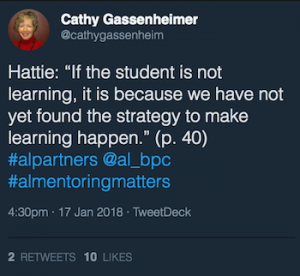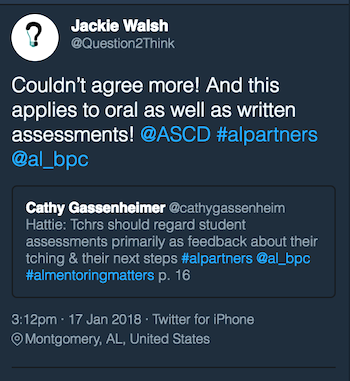 One of the last people that I expected John Hattie to mention in his latest book is Taylor Swift. But, there she was. Hattie wrote of a time he was in Brussels and had a few hours to spare before flying home. He opted for the sunshine and warmth of the city center and quickly noticed three teenage girls:
One of the last people that I expected John Hattie to mention in his latest book is Taylor Swift. But, there she was. Hattie wrote of a time he was in Brussels and had a few hours to spare before flying home. He opted for the sunshine and warmth of the city center and quickly noticed three teenage girls:
[The girls] were trying to imitate the dance move Taylor Swift performs in the video to her song ‘Shake it Off.’ It was impressive to see how the three girls exerted themselves, how they tried again and again to get a little further into the song, with what intensity they discussed and practiced the moves, copying and correcting each other, how they took mistakes as an opportunity, and – last but not least – how much fun they had doing it. Learning was visible in these moments. An hour flew by as I watched, and I left of the airport as the three girls continued to practice. I asked myself: Why can’t school be like this? (p. 160)
 10 Mindframes for Visible Learning: Teaching for Success, by John Hattie and Klaus Zierer, is a compelling read, and more accessible than some of Hattie’s previous books. Organized into eleven chapters – the ten mindframes and the authors’ vision for education for all students – the book is one of those “must reads” for all teachers and leaders committed to professional growth.
10 Mindframes for Visible Learning: Teaching for Success, by John Hattie and Klaus Zierer, is a compelling read, and more accessible than some of Hattie’s previous books. Organized into eleven chapters – the ten mindframes and the authors’ vision for education for all students – the book is one of those “must reads” for all teachers and leaders committed to professional growth.
For those who might not be aware of Australian educator John Hattie, he spent most of his adult education career examining studies of effective teaching and learning. It took him more than 15 years to publish Visible Learning, a compilation of his “meta-analysis” research that provided a listing of teacher and student actions/steps, rated by learning effectiveness. The impact of his work has been enormous.
Each chapter in 10 Mindframes begins with a self-reflection questionnaire that the reader completes and is invited to revisit at the end of the chapter. A vignette that brings the highlighted mindframe to life comes next. Each chapter also includes a short section titled “What is this chapter about?” and another highlighting “Which factors from Visible Learning support this mindframe?” Every chapter also offers a “Where can I start” section, along with a checklist and suggested exercises.
The hinge effect
In his first book, Visible Learning, Hattie highlighted teacher and student actions that achieved at least a 0.4 impact annually (the “hinge” point). When translated into non-research terminology, it means that if this action or strategy is used consistently and effectively in the classroom, it could result in a year’s growth for students. You can review the latest update of Hattie’s list here.
The 10 Mindframes
- I am an evaluator of my impact on student learning.
- I see assessment as informing my impact and next steps.
- I collaborate with my peers and my students about my conceptions of progress and my impact.
- I am a change agent and believe all students can improve.
- I strive for challenge and not merely ‘doing your best’
- I gave and help students understand feedback and I interpret and act on feedback given to me.
- I engage as much in dialogue and monologue.
- I explicitly inform students what successful impact looks like from the outset.
- I build relationships and trust so that learning can occur in a place where it is safe to make mistakes and learn from others.
- I focus on learning and the language of learning.
For some discussion about each mindframe, read this Corwin Connect blog post.
A summary in my tweets
 There is so much wisdom included in this book that I tweeted—a lot—about it as I was reading. You can find those tweets at @al_bpc. Scroll down to see where they start. The early ones were retweeted from my personal account. (Look in time period from January 17 to January 26.) I’ve sprinkled a few (with added comments from Jackie Walsh) throughout this post.
There is so much wisdom included in this book that I tweeted—a lot—about it as I was reading. You can find those tweets at @al_bpc. Scroll down to see where they start. The early ones were retweeted from my personal account. (Look in time period from January 17 to January 26.) I’ve sprinkled a few (with added comments from Jackie Walsh) throughout this post.
Direct instruction may not be what you think it is
There are many insights and “surprises” in the book. For example, in the “I Engage as Much In Dialogue as Monologue” chapter, Hattie explains what direct instruction is and isn’t.
Direct instruction is near the top of the rankings, with an effect size of 0.59, but it is very misunderstood…so often direct instruction is misinterpreted as teacher talking, following scripts built by others and mechanically following a set of recipes. Indeed, this is not direct instruction (p. 109).
 Instead, Hattie explains, direct instruction requires teachers to provide students with clear learning targets, accompanied by success criteria (what mastery looks like). In direct instruction, teachers “build commitment and engagement in the learning task.” Throughout the lesson, teachers model, check for understanding and provide “worked examples.” Teachers use “guided practice” to ensure students understand the concept and solve problems correctly. And, this is followed by independent practice.
Instead, Hattie explains, direct instruction requires teachers to provide students with clear learning targets, accompanied by success criteria (what mastery looks like). In direct instruction, teachers “build commitment and engagement in the learning task.” Throughout the lesson, teachers model, check for understanding and provide “worked examples.” Teachers use “guided practice” to ensure students understand the concept and solve problems correctly. And, this is followed by independent practice.
Because of the rampant misunderstanding of direct instruction, Hattie prefers to call it “deliberate teaching and learning (DTL)”. He explains, “DTL is, therefore, a type of instruction in which both the teacher and the learners know precisely who is supposed to do what, when, why, how, and where and with whom they are supposed to do it” (p. 110).
No wonder DTL, aka direct instruction, shows such a high impact on learning!
Using jigsaws for learning and lesson planning
Later in the same chapter, Hattie explains the power of using the jigsaw activity, which has an impact of 1.09. Those of you who have participated in Jackie Walsh’s and my professional learning are familiar with the jigsaw protocol, in which participants learn more about a concept by “dividing and conquering.”
 In a jigsaw, each learner in a small group is assigned a part of a concept to read and learn about. They then meet for discussion and meaning-making with learners from other small groups who were assigned the same topic. Next, they return to their original “home table” group to teach their colleagues about what they’ve learned. In turn, their home table colleagues teach them about their specific assignment.
In a jigsaw, each learner in a small group is assigned a part of a concept to read and learn about. They then meet for discussion and meaning-making with learners from other small groups who were assigned the same topic. Next, they return to their original “home table” group to teach their colleagues about what they’ve learned. In turn, their home table colleagues teach them about their specific assignment.
In the book, Hattie suggests a way that the jigsaw can be used for lesson planning. He suggests that, ideally, teachers be seated at five tables of five teachers each, with each person assigned a specific Visible Learning influence. For example, at each table, a teacher would study one of these five influences so that all five were studied:
- Classroom Discussion
- Teacher Clarity
- Collaborative Grouping
- Direct Instruction
- Class Size
After meeting with others assigned their same topic, teachers would return to their “home table” to share what they’ve learned. Each table would then review a pre-selected lesson plan to consider the content and delivery of the lesson related to the studied influences (pp. 112-113).
Hattie and Zierer have a dream
The visionary conclusion of 10 Mindframes for Visible Learning literally brought me to my feet. Reading it was uplifting because of the power of the words, which are both challenging and inspiring.
Hattie and Zierer organize their vision using Martin Luther King’s “I Have a Dream” speech. If you have an Amazon account you can sign in, go to the book page, click on the cover, and search for “vision” or “page 166” and read their “vision of a school for the future.” I’ve excerpted just the beginning of their dream here:
We want all students to learn precious and productive knowledge—to critique, reorganize, disrupt, and celebrate this knowledge and to learn what they would not learn if they did not come to school.
The purpose of education should never be to meet the needs of children; what a lowly aspiration this is that helps keep kids in their place—the rich man in the castle, the poor boy and girl at the gate. The purpose of education should not be to help students reach their potential, as again this lowers the aspirations for many and defeats the purpose of schooling.
The prime purpose of education is to help students exceed what they think is their potential. To see in students something they may not see in themselves and to imbue them with our passion for learning.
So, don’t wait. Order your copy of 10 Mindframes for Visible Learning. You’ll find it both inspiring and challenging. And, it just might change the way you look at teaching, coaching, and leading schools.

0 Comments on "10 Mindframes for Visible Learning: Hattie’s Most Accessible Book!"